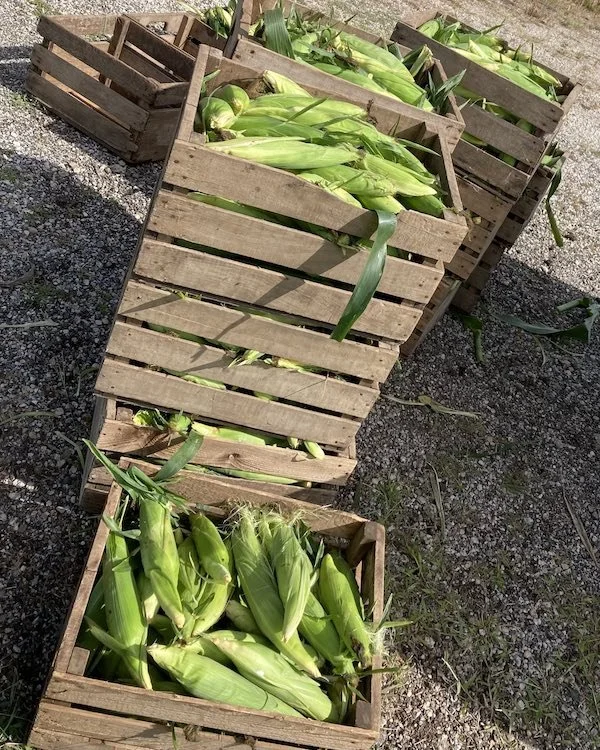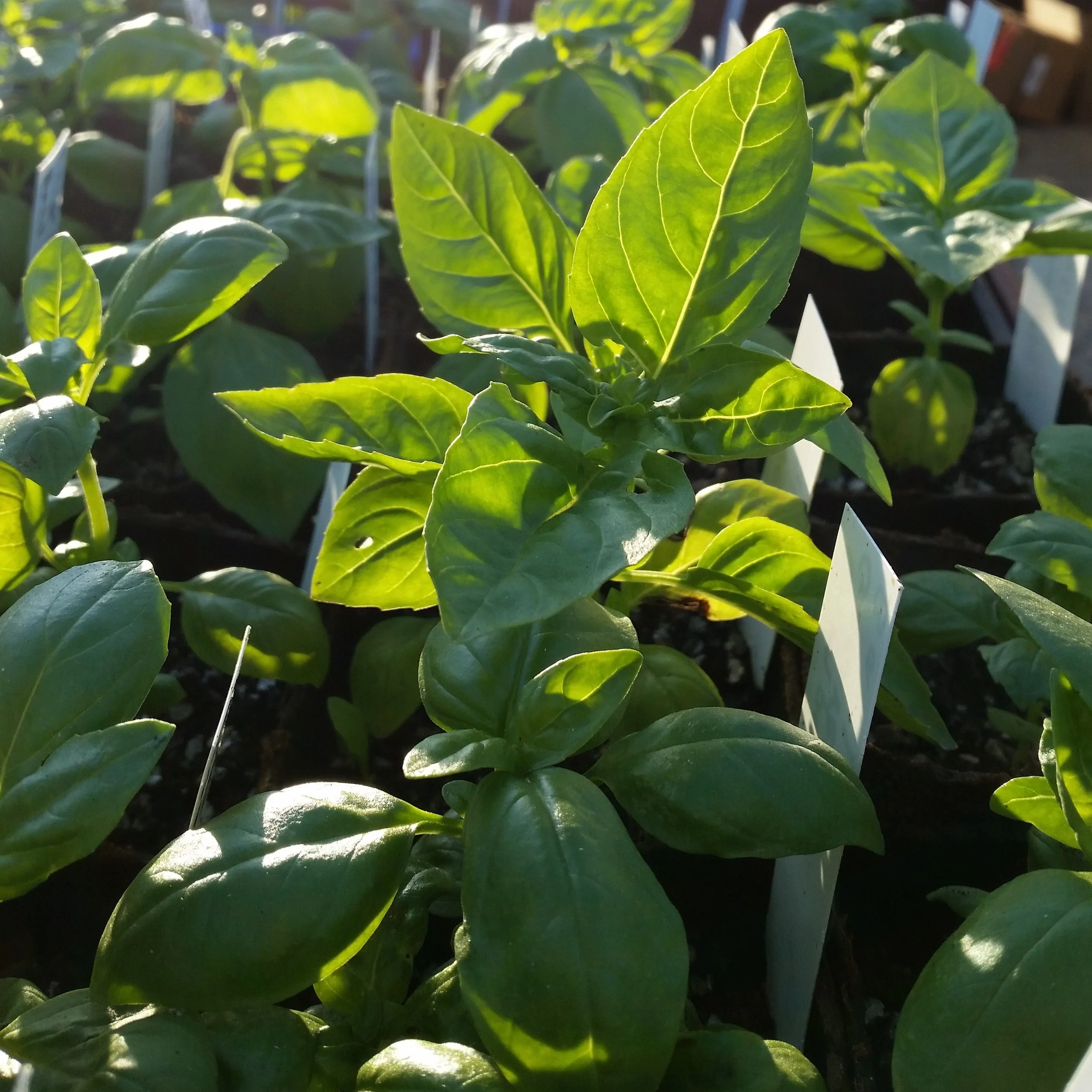CSA #11 (8/5/2025)
Henry took time out of his busy day today to lead a tour and tell folks how he’s managed to have a successful and sustainable vegetable farm for over 30 years. Probably the most important factor is that, “I just out and out work my butt off. And I’m really good at it. I not only work long hours, but get a lot done in those hours. I am an incredibly hard worker. A professional athlete. I enjoy physical labor and am good at it. Still at 61 years old, I’m the fastest at almost every job, out-working 20-year-olds.”
Farm Notes: Three examples of how the changed climate is changing what’s in your CSA this week
1) Very slow ramp-up to tomato season
It used to be that August was peak tomato season in central Illinois, but the changed climate, in particular our much hotter June and July, has pushed peak tomato season back to September the past few years — and the same is happening this year.
Henry looked up the data for tomato pollen viability, and it confirmed his suspicions that this past July was just way too hot for successful pollination. That’s because tomato pollen dies, or successfully pollinated fruits abort, when there are even a few nights in a row above 75 degrees, or days above 85. In addition, humidity above 80% also hinders pollen release.
Since we had a few solid weeks of high humidity, plus days over 85 and nights over 75, very few tomatoes have been successfully pollinated so far this season. But now that it’s cooler, the pollen will survive, and if all goes well, you will be enjoying a lot of tomatoes in another few weeks, and throughout September.
2) Not all corn kernels filled out
Unfortunately, the cooler weather has come too late for the corn, whose pollen is also sensitive to heat, and dies when temperatures are above 90 for even a short period of time. That’s the reason you will likely see some sections of the ears of this week’s corn that are not completely filled out with plump kernels. Those sunken or partial kernels may look something like real corn but they’re not, so just eat the plump kernels surrounding them!
3) Very few zucchini and other summer squashes
The third example of your CSA share changing due to the changed climate is what you haven’t seen much of this year: zucchini and other summer squash. The culprit this time is not pollen-related, but rather bug related . . . but in fact the bug devastation is most likely also weather-related as the heat stressed the plants.
Damage due to the squash vine borer used to be a rare occurence on Henry’s Farm, but this year Henry said just about every plant from his first few plantings has succumbed. That’s because the vine borer fly lays eggs on the stems, and when the larvae hatch, they bore into the stem and eat it from the inside out, which weakens and eventually kills the plant. Henry did get a few good squash from his first plantings, but all of those plants are now dead. There is one more planting getting ready to flower and fruit, and that planting may or may not have the same issues with the vine borers.
The same goes for other plants in the Curcurbit Pepo family, which includes cucumbers, melons, winter squash, and pumpkins. We’ll just have to wait and hope that the cooler temperatures will help with both the vine borer problem and the tomato pollination problem.
Bring an extra bag or box this week for all your produce, including 6 or more ears of sweet corn for each CSA member!
In Your CSA This Week
Sweet Corn - So far this season, the sweet corn you have enjoyed has been from Henry’s fields. But because we know you love sweet corn, and Henry does not have enough acreage to grow much of it, this week’s corn comes to you courtesy of our Certified Organic farmer neighbors Pete Wettstein and Larry Wettstein. It’s likely you’ll get 6 or more ears, so be sure to bring an extra bag for it!
Tomatoes — As mentioned above, the tomatoes are taking a long time to ramp up due to the very hot June and July, and resulting poor pollination. We hope there will be enough to give you at least one or two tomatoes this week, but won’t know for sure until the harvest tomorrow morning. But don’t worry, if this year is anything like last year, you will be getting LOTS of tomatoes in late August and through most if not all of September.
Basil - See Food Notes below.
Bell Peppers
Cucumbers
Garlic
Food Notes: BASIL!
Basil has a rich history and diverse lore, believed to have the power to ward off evil spirits, attract love, and heal whatever ails you. And just a few leaves can enliven any meal, from a stir-fry, to a potato or egg salad, to pizza. But if you have more than a few leaves, as you will this week, make pesto!
Marcella Hazan's Classic Pesto (from Essentials of Classic Italian Cooking)
2 cups packed fresh basil leaves
1/2 cup extra virgin olive oil
3 Tb pine nuts (I use almonds or walnuts)
2 garlic cloves
salt
1/2 cup freshly grated parmigiano-reggiano
2 Tb freshly grated romano cheese
3 Tb butter at room temperature
1. Wash the basil in cold water and pat dry. (I generally omit this step!)
2. Put basil, olive oil, nuts, garlic and an ample pinch of salt in the food processor and process until creamy.
3. Transfer to a bowl and stir in the grated cheeses. Then mix in the softened butter. Serve on pasta or vegetables. (I also spread on bread or crackers, or add to a sour cream dip.)
Pesto Trapanese
In her excellent history/cook book Pomp and Sustenance: Twenty-five Centuries of Sicilian Food, Mary Taylor Simeti says that this pasta sauce originated in Trapani, most likely introduced by the Arabs because it depends on ground almonds for texture, a common technique in classical Arabic cooking.
6 garlic cloves
1 tsp salt
1 cup packed fresh basil leaves
1 cup blanched almonds, roughly chopped
4 ripe tomatoes, peeled and chopped
1/2 cup olive oil
black pepper
1 1/2 pounds spaghetti
1. In a mortar or food processor, grind the garlic, salt, and basil into a paste. Add the almonds little by little and then the tomatoes.
2. When all the ingredients are reduced to a pulp, add the oil and the pepper.
3. Cook the pasta, drain, and toss in a serving bowl together with the pesto. Serve at once.
BASIL LIME SORBET
1 1/4 cups sugar
1 cup water
1 cup fresh lime juice
18 to 20 fresh basil leaves, finely chopped
Sprig of fresh basil for each serving as a garnish
In a medium saucepan over medium heat, combine sugar and water. Stir until mixture comes to a boil; boil 1 minute. Remove from heat.
In a food processor or blender, puree lime juice, sugar syrup, and chopped basil leaves.
Ice Cream Maker - Transfer mixture to ice cream maker, process according to manufacturer's instructions.
Freezer Method - Pour into container, cover, and place mixture in the freezer. When it is semi-solid, mash it up with a fork and refreeze again. When frozen, place in a food processor or blender and process until smooth. Cover and refreeze until serving time.
When ready to serve, place 3 scoops in a stemmed glass. Garnish with a sprig of fresh basil.
Henry will bring some ears of corn with the delicacy known as Huitlacoche (or corn smut) to the Bloomington CSA. If you are in-the-know, or feeling adventurous, just let Henry know you want some of this delicate “corn mushroom.” Since different ears have different amounts of the mushroom, he’ll let you know how many ears of regular sweet corn to substitute for particular ears of huitlacoche. Enjoy!






